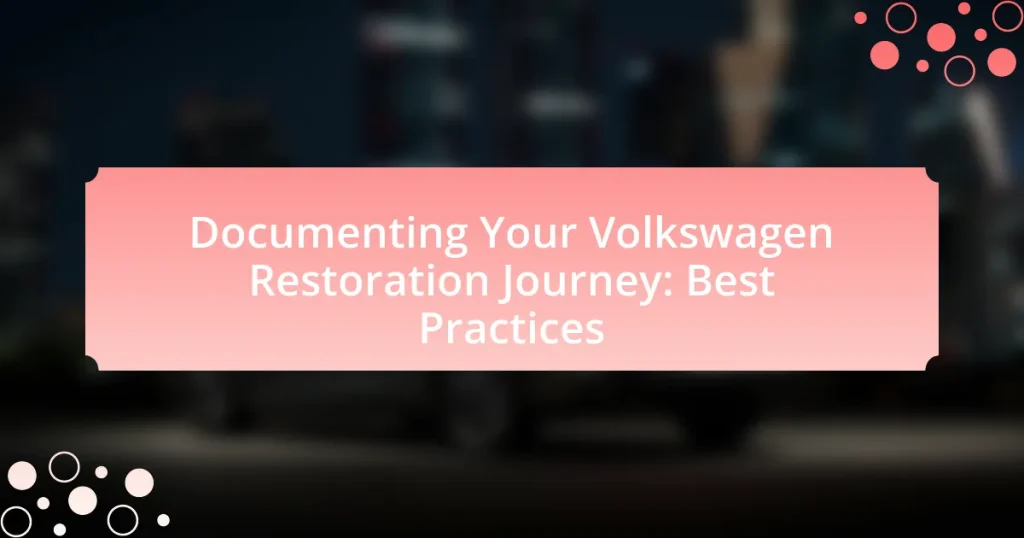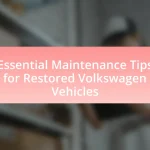Documenting your Volkswagen restoration journey involves systematically recording each phase of the process through photographs, notes, and detailed descriptions. This practice is essential for tracking progress, addressing challenges, and enhancing the vehicle’s value by providing proof of quality and authenticity. Key aspects of effective documentation include maintaining organized records, utilizing digital tools for accessibility, and engaging with the automotive community for feedback and support. The article outlines best practices for documentation, the importance of accuracy, and the impact of thorough records on project management and historical preservation.
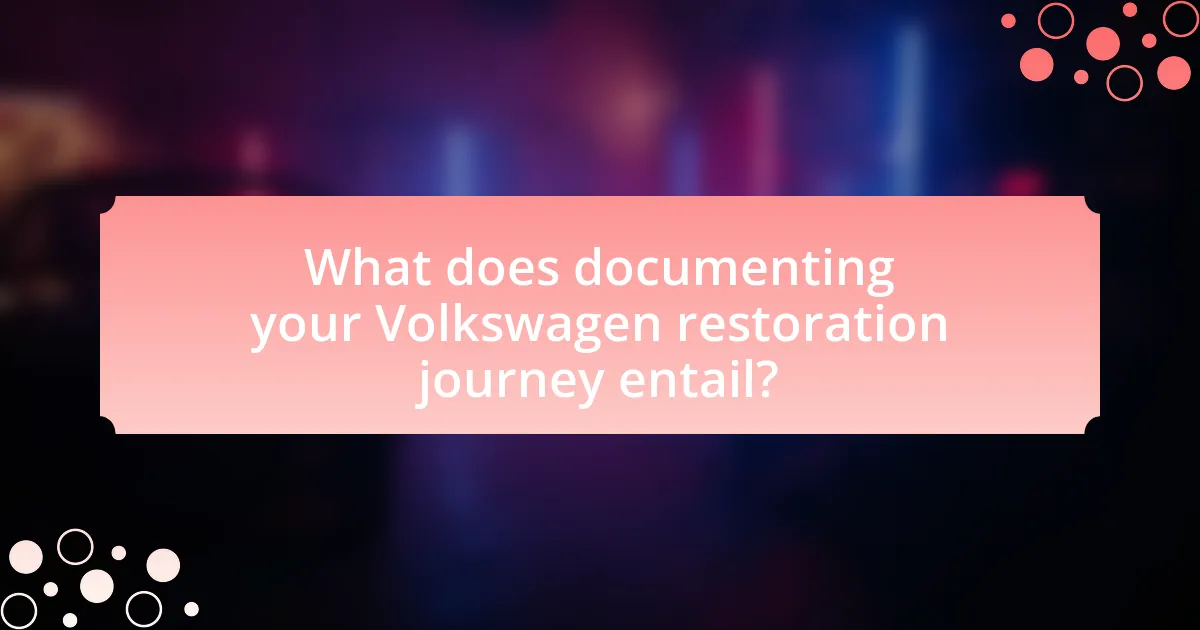
What does documenting your Volkswagen restoration journey entail?
Documenting your Volkswagen restoration journey entails systematically recording each phase of the restoration process, including photographs, notes, and detailed descriptions of the work performed. This practice not only provides a visual timeline of progress but also helps in tracking challenges faced and solutions implemented, which can be beneficial for future restorations or for sharing with the automotive community. Accurate documentation can enhance the vehicle’s value by providing proof of the restoration quality and authenticity, as seen in classic car markets where detailed records can significantly increase resale value.
Why is documentation important in the restoration process?
Documentation is crucial in the restoration process because it provides a detailed record of the work completed, decisions made, and parts used. This comprehensive record helps ensure that the restoration adheres to best practices and maintains the vehicle’s authenticity. Furthermore, documentation can serve as a valuable resource for future maintenance, resale value, and historical reference, as it demonstrates the quality and extent of the restoration efforts. For instance, a study by the Classic Car Club of America highlights that well-documented restorations can increase a vehicle’s market value by up to 30%, underscoring the financial benefits of thorough documentation.
How does documentation enhance project management?
Documentation enhances project management by providing a clear and organized record of project goals, processes, and progress. This clarity facilitates communication among team members, ensuring everyone is aligned and aware of their responsibilities. Furthermore, well-maintained documentation serves as a reference point for decision-making, helping to mitigate risks and avoid misunderstandings. Studies show that projects with comprehensive documentation are 30% more likely to meet their objectives on time and within budget, highlighting the critical role documentation plays in successful project management.
What role does documentation play in preserving history?
Documentation plays a crucial role in preserving history by providing a systematic record of events, experiences, and artifacts. This systematic record allows future generations to access and understand the past, ensuring that cultural, social, and technological developments are accurately represented. For instance, historical documents such as letters, photographs, and official records serve as primary sources that historians rely on to reconstruct events and analyze societal changes. The preservation of these documents enables a comprehensive understanding of historical contexts, as evidenced by the extensive archives maintained by institutions like the Library of Congress, which houses millions of documents that reflect the American experience.
What types of documentation should be included?
The types of documentation that should be included in a Volkswagen restoration journey are photographs, receipts, parts lists, and restoration logs. Photographs capture the condition of the vehicle before, during, and after restoration, providing a visual history of the project. Receipts serve as proof of purchases for parts and services, which can be important for budgeting and resale value. Parts lists detail all components used in the restoration, ensuring that everything is accounted for and can aid in future repairs. Restoration logs chronicle the steps taken throughout the process, including challenges faced and solutions implemented, which can be valuable for both personal reference and sharing with others in the restoration community.
What are the essential records to keep during restoration?
The essential records to keep during restoration include detailed photographs, receipts for parts and services, a log of work completed, and any correspondence related to the project. Detailed photographs document the condition of the vehicle before, during, and after restoration, providing visual evidence of progress and changes made. Receipts for parts and services serve as proof of expenses and can be crucial for future resale value. A log of work completed tracks the specific tasks performed, timelines, and any challenges encountered, which can be beneficial for reference in future projects. Correspondence related to the project, such as communications with suppliers or restoration experts, can provide context and insights into decisions made throughout the restoration process. Keeping these records ensures a comprehensive account of the restoration journey, enhancing both the experience and the vehicle’s value.
How can photographs contribute to the documentation process?
Photographs significantly enhance the documentation process by providing visual evidence of progress and changes over time. They capture specific details of each restoration phase, allowing for accurate tracking of modifications and repairs made to the Volkswagen. For instance, before-and-after images can illustrate the effectiveness of restoration techniques, while close-up shots can highlight intricate work on components. This visual documentation not only serves as a historical record but also aids in sharing the journey with others, fostering community engagement and knowledge exchange among enthusiasts.
How can you effectively organize your documentation?
To effectively organize your documentation, create a structured system that categorizes information by project phases, such as planning, execution, and completion. This approach allows for easy retrieval and reference, ensuring that all relevant documents, such as receipts, manuals, and photographs, are systematically filed. For instance, using digital tools like cloud storage can enhance accessibility and collaboration, while physical binders can be used for tangible documents. Research indicates that organized documentation can improve project efficiency by up to 30%, as it reduces time spent searching for information.
What tools and methods can be used for organizing records?
Digital tools such as cloud storage services, project management software, and specialized record-keeping applications are effective for organizing records. Cloud storage services like Google Drive and Dropbox allow users to store and categorize documents easily, providing access from multiple devices. Project management software, such as Trello or Asana, helps track progress and organize tasks related to the restoration process. Additionally, specialized applications like Evernote or Notion enable users to create structured notes and databases for detailed record-keeping. These tools enhance efficiency and ensure that all relevant information is systematically organized and easily retrievable.
How can digital platforms enhance your documentation efforts?
Digital platforms can enhance your documentation efforts by providing tools for efficient organization, real-time collaboration, and easy access to information. These platforms allow users to store images, videos, and notes in a centralized location, making it easier to track progress and share updates with others involved in the restoration process. For instance, cloud-based services like Google Drive or Dropbox enable users to access their documentation from any device, ensuring that important information is always available. Additionally, platforms such as Trello or Asana facilitate task management and collaboration, allowing multiple contributors to work on documentation simultaneously, which can lead to more comprehensive and accurate records of the restoration journey.
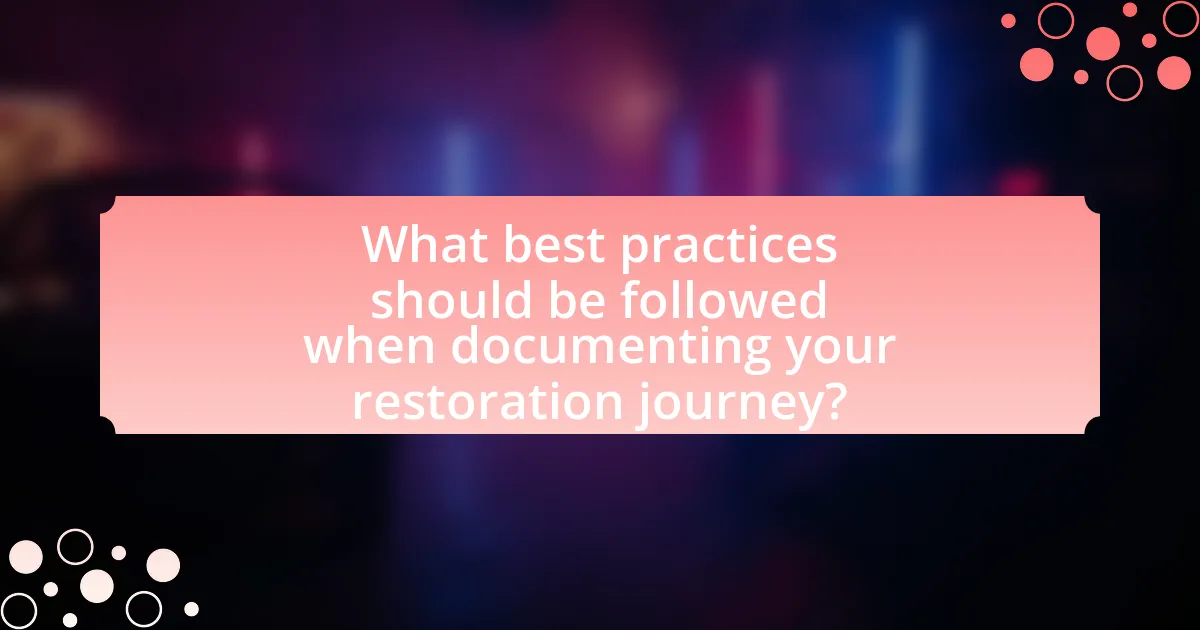
What best practices should be followed when documenting your restoration journey?
To effectively document your restoration journey, maintain a detailed log of each step, including photographs and notes on parts used, techniques applied, and challenges faced. This practice ensures a comprehensive record that can serve as a reference for future projects and provide insights into the restoration process. For instance, documenting the specific paint codes and restoration techniques can help others replicate successful outcomes. Additionally, sharing your journey on platforms dedicated to automotive restoration can foster community engagement and provide valuable feedback, enhancing the overall experience.
How can you ensure accuracy in your documentation?
To ensure accuracy in your documentation, implement a systematic approach that includes thorough research, consistent formatting, and regular reviews. Conducting detailed research on Volkswagen restoration techniques and specifications provides a factual basis for your documentation. Consistent formatting helps maintain clarity and organization, making it easier to cross-reference information. Regular reviews, ideally involving peer feedback or expert consultation, can identify errors or omissions, thereby enhancing the overall accuracy of the documentation.
What techniques can help maintain detailed records?
Techniques that can help maintain detailed records include using digital tools, establishing a consistent filing system, and regularly updating documentation. Digital tools such as project management software or cloud storage solutions enable easy access and organization of records, ensuring that all information is stored in a centralized location. A consistent filing system, whether physical or digital, allows for quick retrieval of documents and helps maintain order. Regularly updating documentation ensures that all changes and progress are accurately reflected, which is crucial for tracking the restoration journey effectively. These methods are supported by best practices in project management, which emphasize the importance of organization and regular updates for successful documentation.
How can you verify the information you document?
To verify the information you document, cross-reference it with reliable sources such as manufacturer manuals, expert forums, and restoration guides. This approach ensures accuracy and credibility in the details you record. For instance, consulting the official Volkswagen service manuals provides specific technical data and specifications that can confirm the authenticity of your documented information. Additionally, engaging with experienced restorers in dedicated online communities can offer insights and validation for your findings, reinforcing the reliability of your documentation.
What common mistakes should be avoided in documentation?
Common mistakes to avoid in documentation include lack of clarity, inconsistent formatting, and insufficient detail. Clarity is essential; unclear language can lead to misunderstandings about the restoration process. Inconsistent formatting can confuse readers and make it difficult to follow the documentation. Insufficient detail may result in critical steps being overlooked, which can hinder the restoration project. According to a study by the International Journal of Information Management, clear and consistent documentation significantly improves project outcomes and user satisfaction.
How can incomplete records impact your restoration project?
Incomplete records can severely hinder your restoration project by leading to misinformed decisions and increased costs. When documentation is lacking, it becomes challenging to track the history and condition of parts, which can result in purchasing incorrect components or overlooking necessary repairs. For instance, a study by the Automotive Restoration Association indicates that projects with incomplete documentation experience a 30% increase in budget overruns due to unforeseen issues arising from unrecorded prior work. This lack of clarity can also extend project timelines, as additional time is spent resolving discrepancies and sourcing the right materials.
What are the pitfalls of neglecting visual documentation?
Neglecting visual documentation can lead to significant pitfalls, including loss of critical information and decreased project transparency. Without visual records, it becomes challenging to track progress, identify issues, and communicate effectively with stakeholders. Research indicates that projects lacking visual documentation often experience delays and increased costs, as teams may need to revisit completed work to resolve misunderstandings or errors. Furthermore, visual documentation serves as a valuable reference for future restorations or repairs, and its absence can result in repeated mistakes or inefficient practices.
How can you share your documentation with others?
You can share your documentation with others by utilizing cloud storage services, email, or collaborative platforms. Cloud storage services like Google Drive or Dropbox allow you to upload your documents and share links with others, enabling easy access. Emailing the documentation directly to individuals ensures they receive the information promptly. Collaborative platforms such as Notion or Trello facilitate real-time sharing and editing, allowing multiple users to contribute to the documentation. These methods are effective for sharing detailed restoration processes and insights with fellow enthusiasts or project collaborators.
What platforms are best for showcasing your restoration journey?
The best platforms for showcasing your restoration journey are Instagram, YouTube, and Facebook. Instagram allows for visual storytelling through photos and short videos, making it ideal for sharing progress updates and engaging with a community of enthusiasts. YouTube provides a platform for detailed video documentation, tutorials, and project walkthroughs, which can attract a larger audience interested in restoration techniques. Facebook groups offer a space for community interaction, sharing experiences, and receiving feedback from fellow restorers. These platforms collectively enhance visibility and foster connections within the restoration community.
How can community engagement enhance your documentation efforts?
Community engagement can significantly enhance documentation efforts by providing diverse perspectives and valuable feedback. Engaging with a community of Volkswagen restoration enthusiasts allows for the sharing of tips, techniques, and experiences that can improve the quality and accuracy of documentation. For instance, collaborative platforms like forums and social media groups enable users to contribute their insights, which can lead to more comprehensive guides and troubleshooting resources. Research indicates that community-driven documentation often results in higher user satisfaction and increased accuracy, as seen in projects like Wikipedia, where collective input leads to more reliable information.
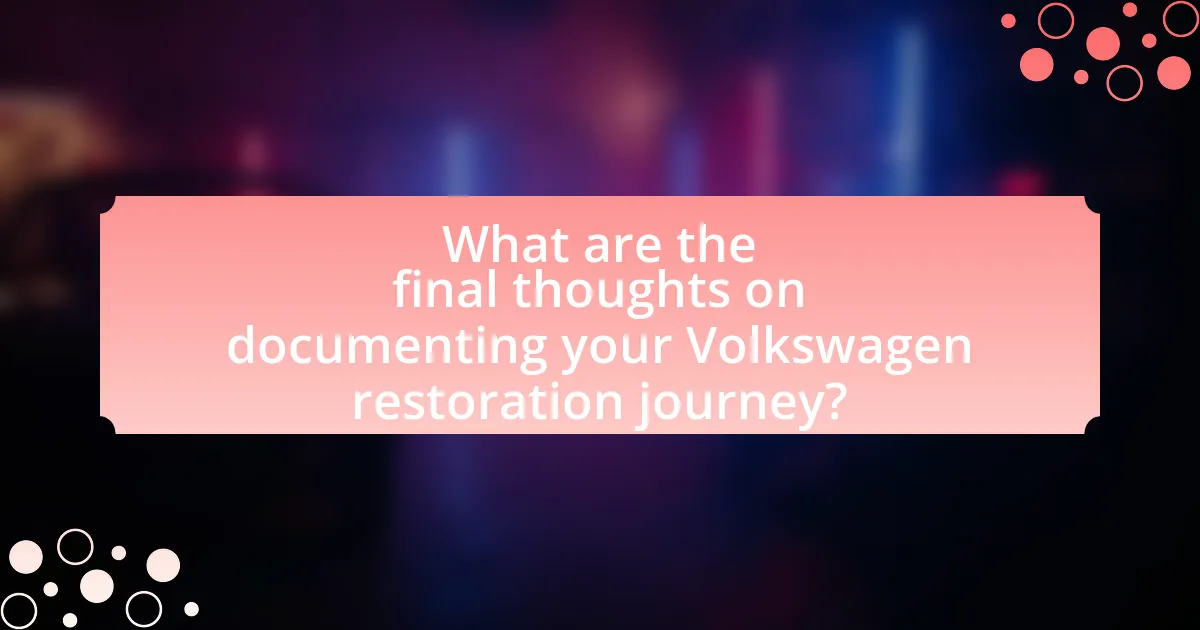
What are the final thoughts on documenting your Volkswagen restoration journey?
Documenting your Volkswagen restoration journey is essential for preserving the process and sharing knowledge with others. This documentation serves as a valuable resource for both personal reflection and community engagement, allowing restorers to track progress, troubleshoot issues, and celebrate milestones. Additionally, well-documented projects can enhance the value of the vehicle, as detailed records can attract potential buyers by showcasing the effort and care invested in the restoration.
What practical tips can improve your documentation process?
To improve your documentation process, implement a structured approach that includes consistent formatting, clear labeling, and regular updates. Consistent formatting ensures that all documents are easily navigable and comprehensible, while clear labeling helps in quickly identifying the content of each document. Regular updates keep the documentation relevant and accurate, reflecting any changes made during the restoration process. According to a study by the Project Management Institute, effective documentation practices can enhance project success rates by up to 20%, highlighting the importance of these tips in achieving a successful Volkswagen restoration journey.
How can you create a consistent documentation routine?
To create a consistent documentation routine, establish a regular schedule for recording progress, ideally daily or weekly. This routine should include specific tasks such as taking photographs, writing notes about each step of the restoration process, and organizing these materials in a dedicated digital or physical space. Consistency is reinforced by setting reminders and using templates for documentation to streamline the process. Research indicates that structured documentation improves project tracking and enhances the quality of information retained, making it easier to reflect on the restoration journey and share insights with others.
What resources are available for further learning about documentation?
Comprehensive resources for further learning about documentation include online courses, books, and community forums. Online platforms like Coursera and Udemy offer courses specifically focused on technical writing and documentation best practices. Books such as “The Elements of Technical Writing” by Gary Blake and “Technical Communication” by Mike Markel provide foundational knowledge and practical tips. Additionally, community forums like the Society for Technical Communication (STC) and Reddit’s r/technicalwriting offer peer support and shared experiences, enhancing understanding through real-world examples. These resources collectively support the development of effective documentation skills essential for projects like Volkswagen restoration.
